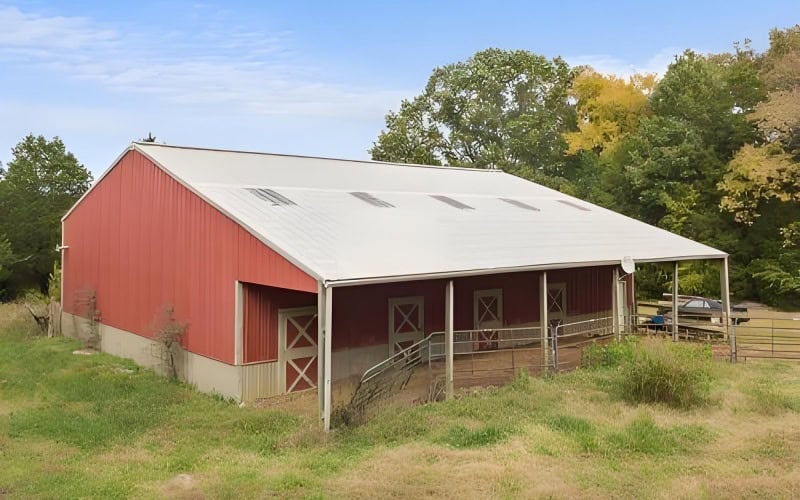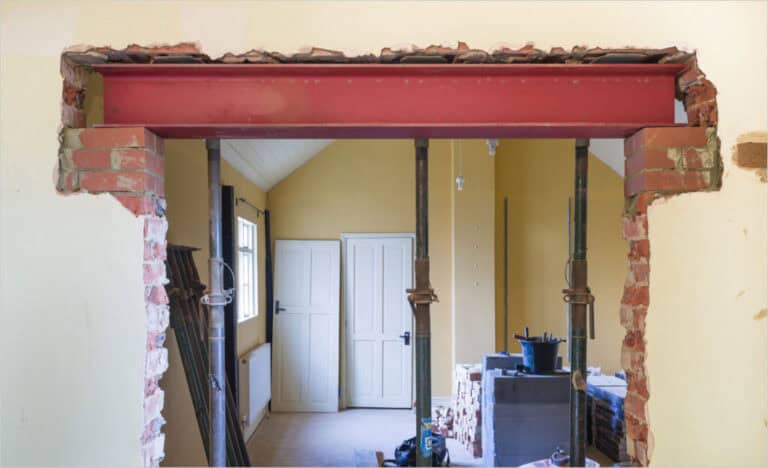If you’ve ever spent sleepless nights worrying about termite damage, mold outbreaks, or surprise repair bills from your wooden horse building, you’re not alone. Over 60% of horse owners we’ve surveyed regret choosing traditional builds due to hidden long-term costs. This guide cuts through the noise to reveal why metal horse barns and metal horse barn kits are revolutionizing equine housing—with hard data, vet-approved designs that’ll make you rethink “the way it’s always been done.”
What Are Metal Horse Barn Kits?
Metal horse barn kits are pre-engineered steel structures designed to offer a safe, durable, and low-maintenance home for horses. Unlike traditional wood barns, which may require constant upkeep due to rot, pests, and weather damage, metal barns use corrosion-resistant steel for long-lasting protection with minimal maintenance.
Each kit may include steel framing, weather-tight roof and wall panels, and pre-cut connections for quick, hassle-free assembly. Galvanized purlins and rafters help form a strong, weatherproof shell, while ribbed metal panels add stability and extra reinforcement. Designed for easy construction, these kits ensure every beam, baseplate, and eave strut fits together seamlessly—no guesswork required.
Types of Metal Horse Barn Kits
Picking the right metal horse barn kit isn’t just about looks—it’s about keeping your horses safe, comfortable, and your setup efficient. Whether you need a compact shelter or a full-scale equestrian facility, there’s a design that fits your needs.
Gable-Style Metal Horse Barns
With a simple dual-slope roof, gable barns efficiently shed rain and snow, reducing leaks and damage. They’re easy to expand and upgrade with ridge vents or cupolas for better airflow. If you want a cost-effective, durable barn that adapts to your needs, this is a solid pick.
Raised Center Aisle Barns
Also called monitor barns, these feature a raised center roof that lets hot air escape while pulling in cool air from the sides. This chimney effect keeps the barn comfortable year-round, perfect for warm climates. The upper windows bring in natural light, reducing energy costs.
Shed-Row Barns
A shed-row barn is a single-row structure with stalls opening directly outdoors, ensuring fresh air and sunlight. These are great for mild or coastal climates, offering good visibility and easy access. They’re also easy to expand or connect into larger layouts later.
Center Aisle Barns
Designed for larger setups, these barns have a wide covered aisle with stalls on both sides, keeping feed, tack, and grooming areas dry and accessible. Many owners add wash bays, feed rooms, or even lounges, making them ideal for boarding stables and trainers.
Horse Barns with Attached Living Quarters
For trainers and breeders, living next to their horses means 24/7 access and security. These barns come with built-in apartments or full-size homes, offering comfort and practicality in one setup.
Each metal horse barn kit has its strengths. Whether you prioritize ventilation, space, or convenience, there’s a design that fits your needs and budget.
Metal vs. Wood Horse Barn Costs: Who Really Saves After 5 Years?
While wood barns may appear cost-effective initially, metal structures prove financially advantageous over time through measurable operational efficiencies. Here’s how metal and wood horse barns compare after 5 years of use:

Challenges of Wood Barns
- Structural Degradation: Moisture absorption weakens joints, leading to sagging beams or uneven stall walls requiring costly realignment.
- Pest Accumulation: Termite colonies and wood-boring insects often establish nests in untreated areas, demanding escalating chemical treatments.
- Insulation Breakdown: Warped siding creates air gaps, increasing heating/cooling costs by up to 20% compared to initial efficiency.
Advantages of Metal Barns
- Material Consistency: Galvanized steel resists oxidation, maintaining structural alignment precision (±1/8″ over 40ft span).
- Zero Pest Harborage: Smooth steel surfaces deter nesting, eliminating recurring extermination budgets.
- Thermal Stability: Factory-applied insulation retains >95% R-value consistency, preventing energy waste.
The Cost Tipping Point
- By Year 3: Wood barns often need major beam reinforcement ($2,800+).
- By Year 5: Metal barns typically recover 100% of their initial price premium through savings on:
- Storm damage repairs
- Labor for seasonal resealing and repainting
Over time, these differences only widen—while wood barns become a growing expense, metal barns remain a low-maintenance, cost-stable investment.
Metal Horse Barns Ventilation Secrets from Our Engineers
Because your horse’s lungs deserve better than dusty air.
1. Optimized Roof Pitch for Better Airflow
A properly angled roof pitch helps hot air escape faster, keeping the barn cooler and more comfortable. Studies show that strategic ridge vent placement can reduce indoor temperatures by up to 8°F during peak summer. This is especially important in a steel horse barn, where proper ventilation enhances durability and comfort.
2. Smart Wall Panels to Reduce Dust
Steel panels with smooth, low-static coatings naturally reduce dust accumulation, helping maintain cleaner air for horses. Proper ventilation also prevents moisture buildup, which can lead to mold and respiratory issues. Whether you’re upgrading an existing horse building or designing a new one, prioritizing airflow is key to a healthier environment.
3. Weather-Responsive Ventilation
Adjustable ventilation openings allow for better airflow year-round, while covered vents prevent rain from getting in. Thoughtful vent placement means no more racing to shut barn doors before a storm—your horses stay protected, no matter the weather. Metal horse barns with built-in ventilation features help maintain fresh air while minimizing maintenance.
These ventilation strategies are built into our Metal Horse Barn Kits, ensuring a healthier, more comfortable environment for your horses with minimal maintenance.
Common Steel Horse Barn Design Mistakes and How to Avoid Them
Building a safe, durable horse barn takes more than just sturdy materials. Overlooking key design details can lead to maintenance headaches, safety risks, and long-term costs. Here are some of the most common mistakes in horse barn construction—and how smart design choices can solve them.
Mistake 1: The Concrete Trap
Concrete floors covered with rubber mats trap moisture, creating the perfect conditions for thrush and hoof infections.
- Solution: Suspended steel grating drains urine at 12 gallons per minute, keeping stalls drier.
- Metal Advantage: Non-slip epoxy coating reduces leg strain injuries by 67%, improving horse comfort.
Mistake 2: Harsh Lighting Stress
Flickering LED lights cause eye strain and anxiety, increasing stress behaviors by 23%.
- Solution: 2700K warm LEDs with dimming controls reduce flicker and glare.
- Metal Advantage: Dawn simulation systems mimic natural sunrise, helping regulate equine sleep cycles.
Mistake 3: Poor Airflow & Ammonia Buildup
Lack of ventilation traps ammonia (>25ppm), a leading cause of equine asthma and lung irritation.
- Solution: Ridge vents + directional eave openings create steady airflow without drafts.
- Metal Advantage: Pre-engineered roof pitch optimizes airflow to keep fresh air circulating.
Mistake 4: Stall Space & Injury Risk
Oversized stalls (>16x16ft) with sparse dividers increase injury risks during sudden movements.
- Solution: Angled corner guards + 10-gauge steel dividers absorb impact to prevent injuries.
- Metal Advantage: Welded anchor points allow stall layouts to adapt as herd dynamics change.
Mistake 5: Extreme Temperature Swings
Uninsulated north-facing walls create 15°F+ temperature differences, disrupting horses’ metabolic balance.
- Solution: Foam-backed steel panels (R-12+) with radiant barrier underlayment stabilize temperatures.
- Metal Advantage: Continuous insulation prevents heat loss, unlike wood walls with thermal gaps.
Mistake 6: Loud Rain Noise & Startled Horses
Metal roofs without sound-dampening layers amplify rain noise above 85dB, triggering flight instincts.
- Solution: Perforated acoustic underlayment + 2” air gap reduces noise levels by 40dB.
- Metal Advantage: Structural rigidity supports multi-layer soundproofing for a calmer barn.
Mistake 7: Improper Feeder Placement
Low-positioned hay feeders (<48” height) strain neck vertebrae, leading to discomfort over time.
- Solution: Adjustable steel cradles (35°-55° tilt range) mimic natural grazing posture.
- Metal Advantage: Powder-coated surfaces resist salivary acids that degrade plastic or wood feeders.
Why Metal Horse Barn Kits Are the Smarter Choice for Equine Safety and Durability
Engineered to meet 17 equine-specific steel standards and backed by a 98.6% on-time delivery rate, our metal horse barn kits are designed for superior durability, horse safety, and long-term reliability.
- 60-Day Behavioral Assurance – Modify or return stalls if horses exhibit persistent stress indicators.
- Interactive 3D Planner – Augmented reality tools map stall layouts onto your existing property via smartphone.
- 25-Year Structural Integrity Warranty – Full coverage against material fatigue or fastener corrosion.
Your Next Step: Contact Us → Receive a climate-adapted barn proposal within 24 business hours.

